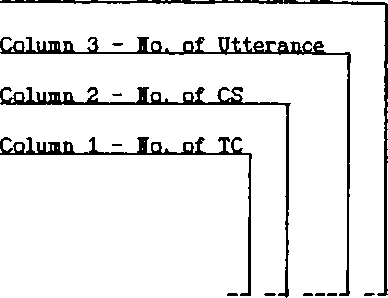Xethod /116
Example 1: CS 03.02
Column 4 - Яо.of Utter.in CS

Coding
Columa A - SPEAKERS
Column B - CQHTEIT
c□ι. c - DYKAMic of Imteractiqh
Column D - Fuhctiqh
Column E - FORM
coi,F-Imfqrmatiqh value
Column G - COMPLEXITY
03 Q2 0527 Ol__4 11 1 12 3 2 0
Speakers: Georglna (Target Child), her mother, and R.(another child).
Context: Georglna has just come back from the market.
Afternoon, In the yard near Georgina's house.
03 02 0527 Ol
R. (Child) I wonder what they've got
(for sale) at the shop
03 02 0528 02
Mother At the co-op?
03 02 0529 03
R. (Child) Fes
4 1 11 12 3 2 0
Child to Target Child
Utterance constitutes a turn
Request Move initiates a unit
and a CS
Seeks information, hypothesis
Open interrogative
Real question
Hon applicable
9 1 0 44 0 0 0
Adult to child
Utterance constitutes a turn
Unsolicited contribution
Seek Clarification, guessing
Hot applicable
Mot applicable
Mot applicable
8 1 5 85 0 0 1
Child to Adult
Utterance constitutes a turn
Request Move, request repeated as
More intriguing information
1. Firm Closure, Financial Losses and the Consequences for an Entrepreneurial Restart2. Intertemporal Risk Management Decisions of Farmers under Preference, Market, and Policy Dynamics
3. The name is absent
4. Psychological Aspects of Market Crashes
5. The name is absent
6. Population ageing, taxation, pensions and health costs, CHERE Working Paper 2007/10
7. The Context of Sense and Sensibility
8. A Study of Adult 'Non-Singers' In Newfoundland
9. The name is absent
10. Monetary Discretion, Pricing Complementarity and Dynamic Multiple Equilibria